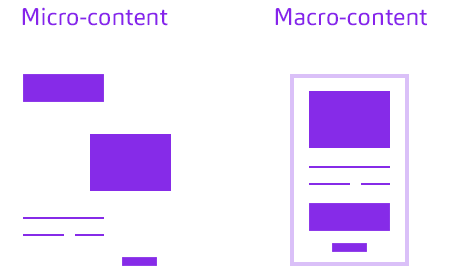Managing the Content Explosion: Micro-Content vs Macro-Content
 Maatje van Broeckhuysen
Maatje van Broeckhuysen

In an omnichannel environment, you often have to authenticate, upload, optimize and publish a single piece of content in more than five different systems. We think there's room for more efficiency here. But how? By disentangling content and making a clear distinction between micro-content and macro-content.
In the past few decades, the amount of content organizations need to publish has exploded, making managing it even more complicated. Something you've experienced firsthand.
Solid content management can be a real differentiator for executing your customer experience strategy. To put it simply, if content managers want to provide relevant content across the entire customer lifecycle, you and your content team colleagues must start working more efficiently. You should overcome barriers including separate channels and siloed content and start managing content as a whole by breaking it down into smaller pieces. Here’s an introduction to micro- and macro-content.
What is micro-content?
Micro-content is a short piece of content that can be employed across different channels. A specific call to action, for example, is micro-content: it can be used on web pages, in social media posts, and in newsletters. An image can also be micro-content, used as a header in an email newsletter and as a rectangular picture featured on an article page.
Micro-content is granular content. When combined, pieces of micro-content can be used by content editors as building blocks for creating macro-content. By approaching content in this way, content managers can transcend their traditional ‘channel-by-channel’ modus operandi and start working more efficiently.

What is macro-content?
Macro-content consists of pieces of micro-content. It can be an article on a web page, an email newsletter, or a social media post. These pieces of macro-content all contain images, text elements, and calls to action. In siloed organizations, a lot of work is replicated — at best. Content within disparate systems follows its own process, has its own tagging, filtering, or related data mechanisms, and is monitored, enriched, and reviewed by different stakeholders. Research shows that in an omnichannel environment, the number of steps a content editor has to take to manage a single piece of content in multiple different systems is in the double digits.
What does this mean for you? Well, if you use pieces of micro-content for your macro-content, you can save loads of time. For example, you won’t need to upload the same picture three or more times. Once is enough. The editor simply selects the image that is needed from all the pieces of micro-content available in the content management system.
What do you need for this micro/macro-content approach?
Your ultimate goals are to free content from silos, build an omnichannel organization, and redesign your content management process into one specifically designed for managing omnichannel micro-content. As a channel specialist (a role often assigned to the content editor, so to you), you can then create macro-content by assembling the pieces of content needed for the channel.
It may sound daunting, but just start small. If you're part of one of the multiple content teams, begin by separating your team's content into micro-content and macro-content. When successful, your team is immediately more effective. From there, you can cautiously take the first steps towards an omnichannel organization.
With an agile approach, a content team can optimally manage micro-content. The creative process of building ideas for products, segmenting customers, value propositions, and designing campaigns takes place before the actual content entry. This approach makes it easier to do incremental optimizations in short cycles based on continuous insights.
What does this mean for your technology?
If you want to create the best experiences for your customers, consider a MarTech solution that truly enables agile content. Modern solutions developed for managing omnichannel micro-content are called agile CMSs. They are designed to save time and money and can help execute an omnichannel customer experience management strategy.



